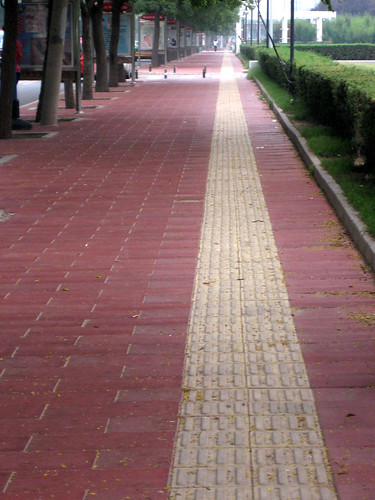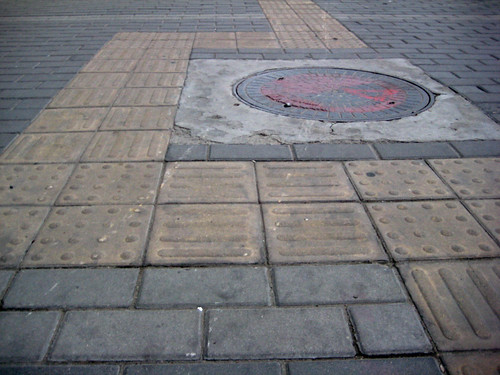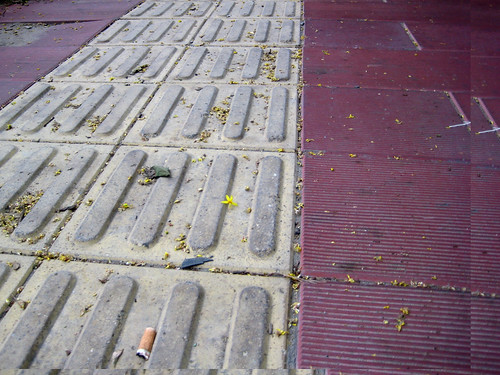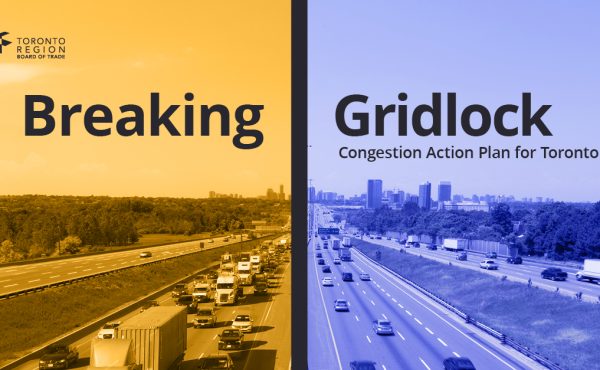
Spacing correspondent Megan Hall is in Beijing this summer. Over the next few weeks, she will be sharing her observations of China’s capital as it prepares to welcome the world to the controversial 2008 Olympic games in August.
– – – – – – – – – – – – – – – – – – – – – – – – –
BEIJING — With the Olympics less than two months away, Beijing is scrambling to put the finishing touches on many buildings in the central areas that tourists will most likely be walking by. Fancy new siding has been in the process of being installed on the government building next to my apartment for a full month now, and signs of completion are finally in sight. Constant sawing and jack hammering can be heard in every corner of the city far away from the Olympic green, but it’s the infrastructure that lies beneath the layer of construction dust that covers Beijing that I has fascinated me.
A raised path for the blind, made up width-wise of two 30-centimetre-long yellow or red square tiles with several raised lines, stretches through every sidewalk and subway station in the city. At an intersection or an obstacle such as a tree, the lines turn to circular bumps to warn of a change in path. Otherwise, the path continues perfectly straight ahead. The raised lines and bumps allow the seeing-impaired to navigate throughout the city with the help of the changing texture under their feet. It helps that Beijing’s streets are as straight as can be and have incredibly large sidewalks to boot.

The path follows all major streets, even into the outskirts, but is absent in neighbourhood, or “hutong,†streets — one-lane alleyways that were never built for cars but attempt to accommodate them, and have never had sidewalks as walking and biking are the primary ways of navigating them. If the hutong in which I live is any indication, a great deal of the elderly population still resides in the houses that they have lived in for decades. Many of the hutongs are being destroyed now, though, to make way for new housing developments and office towers that sport the brightly coloured blind pathways on the sidewalks out front.
A recent article in the weekly edition of the Beijing Review mentions that this extensive network of pathways covers more than 800 sidewalks, over 1,500 kilometres, throughout Beijing and is being expanded at a steady pace. Installation of the path began primarily for the blind about two decades ago, although steps towards outfitting the city for the disabled began just after World War II.
During a recent trip to Shenzhen, I noted that the “blind strip†was also present, as well as in Tianjin, a city just south of Beijing.
Locals do not seem to find the path extraordinary in any way, although most westerners I’ve spoken to here find it a fantastic resource. While I have yet to see the path being put to good use by Beijing’s blind population, many who clearly still have their eyesight use the path — the slate tile often used in tourist areas becomes treacherous when it rains, so the raised lines and bumps actually becomes the safer choice for those who can see.
I got in contact with the manager of a rubber tile production company that supplies blind tiles to cities all over China, but conducts the majority of its work in Qingdao. Although she was unsure of how many tiles were in place in the city, the manager assured me the network was extensive, with some of the biggest projects supplying over 1000 square metres of “blinder tile†(as she calls it) in some areas. The material, made of recycled rubber tires, is supposed to provide a path for the blind that is both comfortable to walk on and anti-slip in case of any water on the sidewalk.
Despite its seeming lack of usage, this part of the infrastructure adds not only texture but colour to the urban fabric of many Chinese cities.





10 comments
I found similar things in Columbus Ohio recently, though they were used only at crosswalks and intersections.
I’ve seen these all over the place in Holland. Not everywhere, but I can’t really remember where they are in particular. (Train platforms, I think, and busy areas in general)
Reminds me of the raised yellow dots on TTC subway platforms, and the raised tiles that lead folks to the stairs/elevators.
In Singapore, they have raised paths in all of the MRT stations (subways). It took me a while to realize that they were meant to aid the blind.
They also have the rubber installed at all crossings, though I’ve always thought they were there to keep people from slipping into traffic. Singapore gets a lot of rain and many of the sidewalks are tiled and therefore slippery.
They have these in Hong Kong too. When I was there recently, I made sure to get some pictures of one path for the blind in a local mall that leads directly toward a huge support column before sharply bending around it and resuming its straight line on the other side. There’s definitely potential for cruel slapstick there.
The same thing exists in Brisbane, Australia, where I grew up. I admit that I didn’t find it remarkable at the time.
Thinking back, I wonder if they were put in for Expo ’88.
It took me a long while to figure out what they were when i was in Japan. They are all over Japan, even in the small towns. It seems that they lead people to the main public places, by changin the textures in front of post offices and train stations.
like jonathan says, they’re all around tokyo. but i heard from many of the locals that while the tiles had proved a boon for the blind, they caused problems for those with wheelchairs or walkers. solve one problem, create another.
WOW Megan Hall in Bejing?!!!!! Is spacing going to compete with the major news media covering the event?What did this trip cost? and who is paying the tab? Just asking….
The purpose of a raised surface for blind
travelers is to provide a tactile indicator for level change. A long bumpy path is not easy to navigate with a cane. If I was blind I would take the path to the right and only trail the edge of the bumpy path.